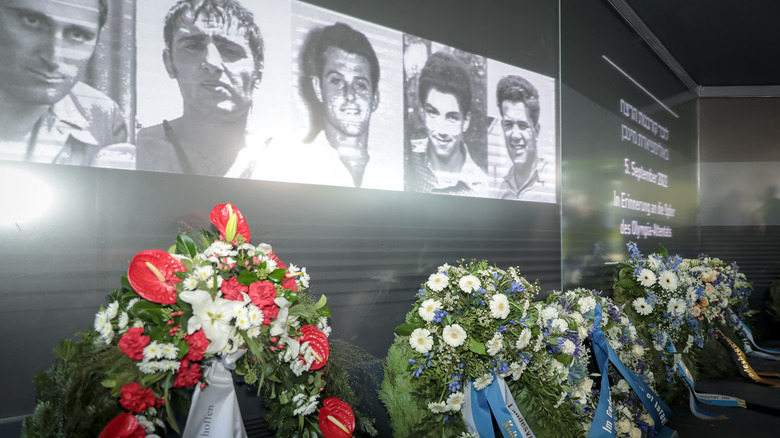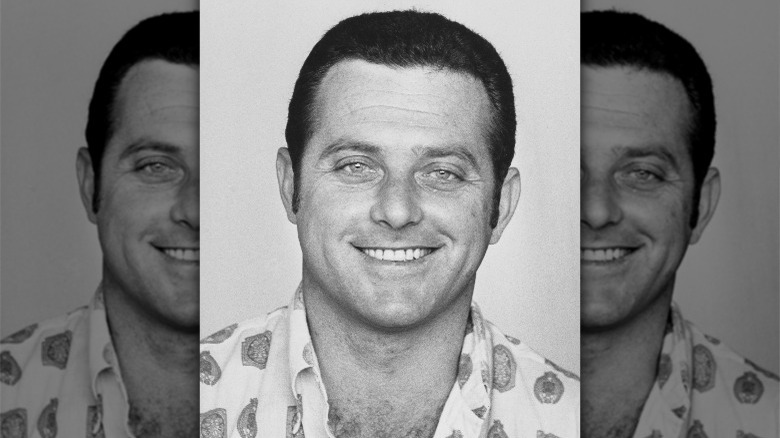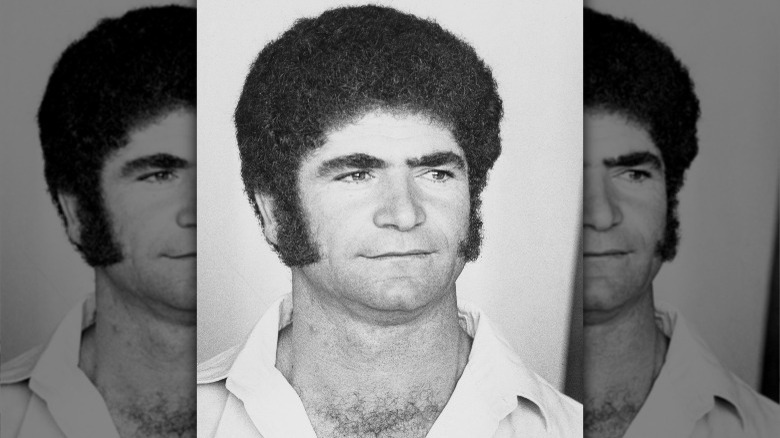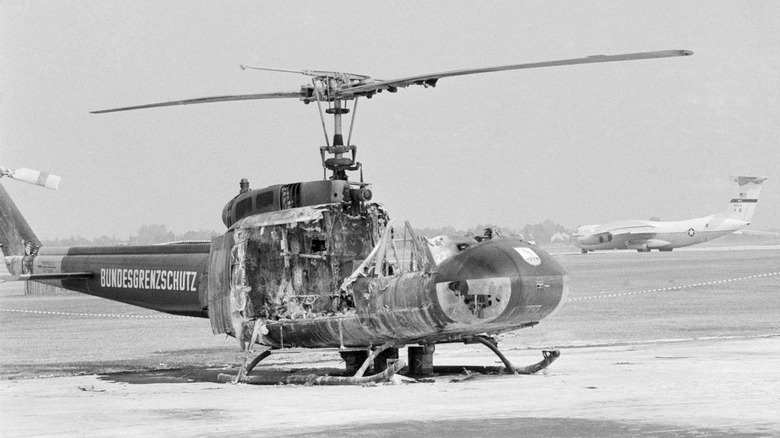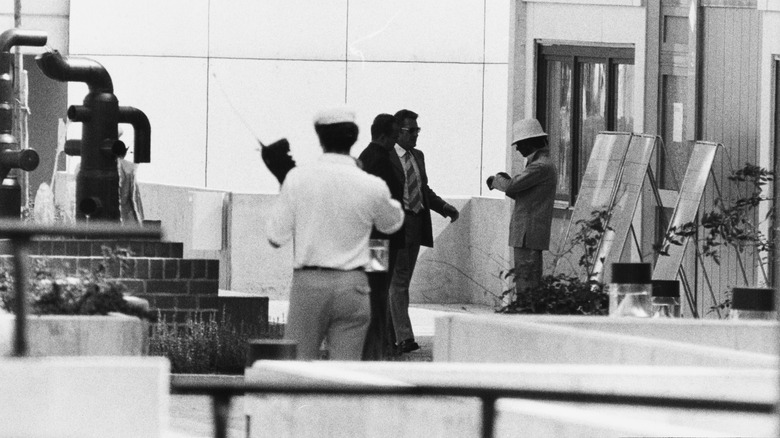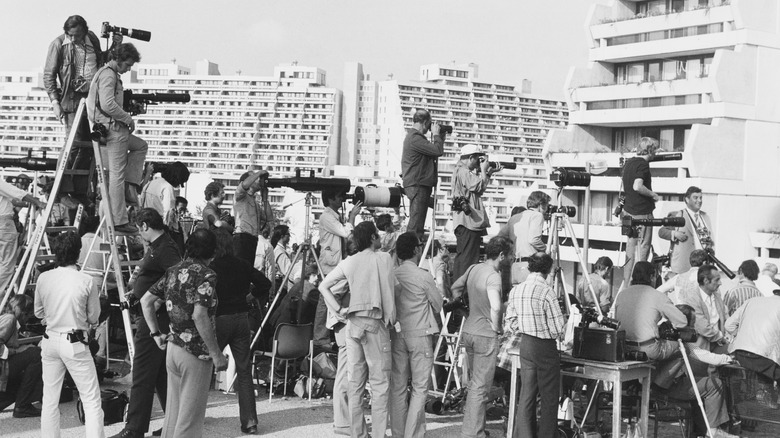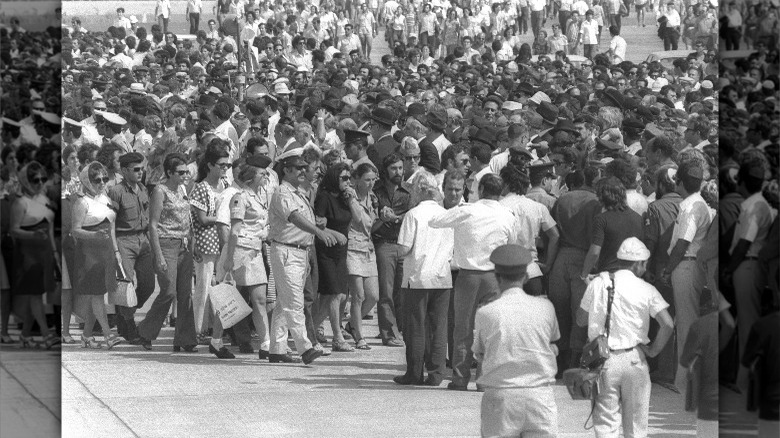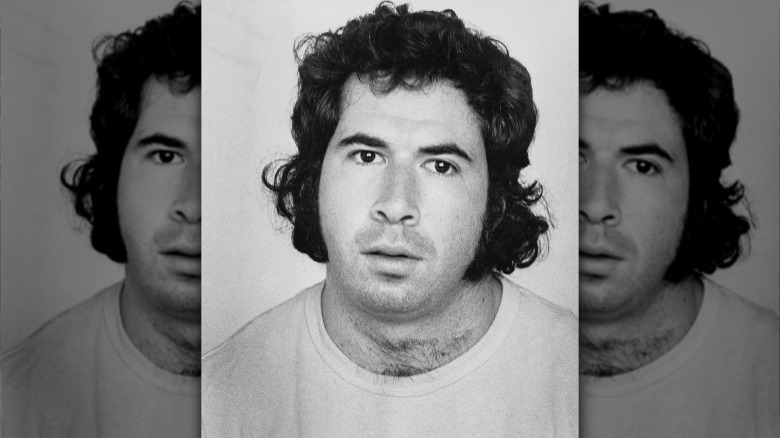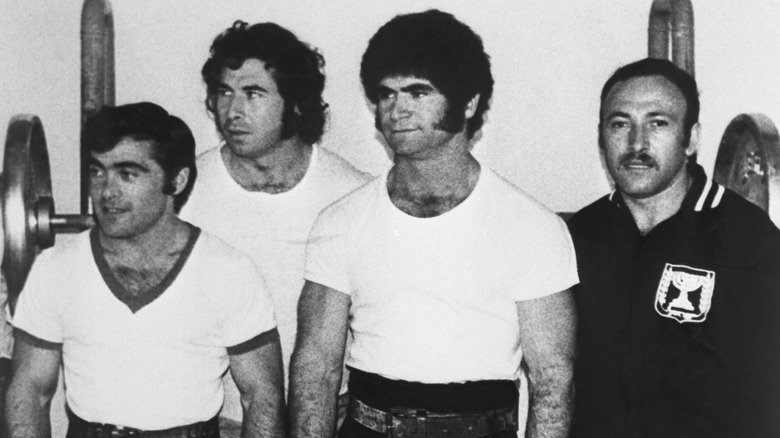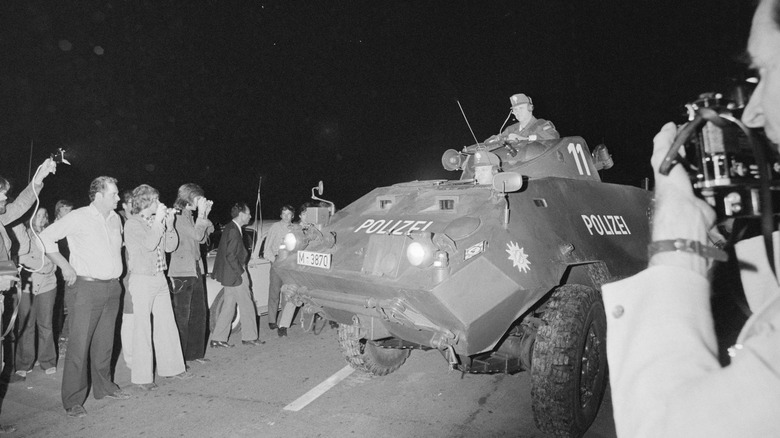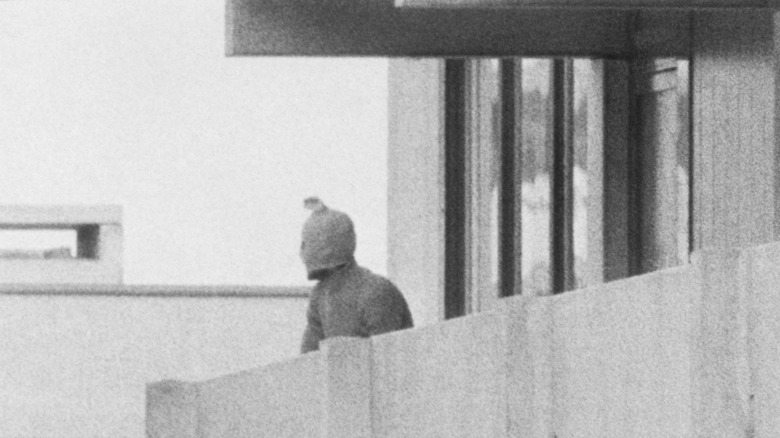What Happened To The Bodies From The Munich Olympics Massacre?
As the 1972 Munich Olympics approached, West German officials had a lot of reason to hope things went off without a hitch. The 1968 Mexico City Olympics infamously began with the massacre of students at Tlatelolco Plaza, and the last time the Olympics had taken place in Germany, Adolf Hitler had come to power and used the Olympic Games as a way to spread Nazi propaganda. German organizers for the 1972 Games were therefore desperate to paint a positive picture, even calling these "The Cheerful Games." Those good intentions were ultimately for naught, though: the event was overshadowed by a massacre, and the fate of the bodies of those who were killed was also mired in controversy.
A week into the Games, on September 5, 1972, eight members of Black September (a militant Palestinian group) snuck into the Olympic Village, targeting the Israeli athletes. Eleven were taken hostage, two of whom were killed in an attempt to escape. The terrorists and their hostages were eventually transported to Fürstenfeldbruck Air Base, where a botched police ambush led to a drawn-out firefight. When the smoke cleared on the morning of September 6, all of the Israeli hostages had been killed, as had one Munich policeman and five of the Palestinian terrorists.
All hopes of a positive experience had been dashed; athletes were killed at the Olympics. Instead, the tragic story of the Munich Olympics would be forever associated with the massacre. This is the story behind the final destination of the victims — and the slain perpetrators — of the 1972 Munich Olympics Massacre.
Moshe Weinberg's body was tossed aside
When the Black September terrorists forced their way into the apartments of the Israeli Olympic delegation, one of the first people they ran into was wrestling coach Moshe Weinberg. Almost immediately, Weinberg was forced to lead the intruders to the rest of the athletes, all while being held at the end of a gun. Weinberg's intentions at that exact moment are somewhat up for debate, but he was ultimately shuttled back into his original apartment, along with the rest of the hostages.
However, the athletes tried to fight back or escape, and in the chaos, Weinberg tried to take one of the terrorists' guns. His attempt was nearly successful, but that wasn't enough, and he was shot and killed in the process. The aftermath of his death, though, was what proved particularly dark.
The precise events are somewhat lost, but members of the East German delegation — who were being housed directly across the street — were able to see exactly what happened. According to handball player Klaus Langhoff, they watched as the terrorists callously tossed Weinberg's body into the middle of the street, right in front of the entrance to the Israeli athletes' housing. And then just left it there. In Langhoff's own words: "His body stayed there for a long time until it was removed. It was an awful sight. Terrible. Horrifying" (via South Florida Sun Sentinel) ... "Whenever we looked out of the window or on the balcony, we saw this dead athlete there" (via The Times of Israel).
Yossef Romano's body was used to send a message
Most of the casualties suffered during the Munich Massacre took place at the Fürstenfeldbruck Air Base. Except for two: Moshe Weinberg and weightlifter Yossef Romano. As it's understood, both Weinberg and Romano took advantage of a moment of confusion to try and disarm the terrorists, Romano even doing so despite an injury. Both were shot in the attempt, but while Weinberg's body was thrown outside the building, Romano was kept inside.
Reports unveiled years later revealed that Romano was left to die on the floor, then, reportedly, the terrorists castrated him — all in front of the other bound hostages. Official investigations are technically unclear as to whether that took place after his death, but Romano's widow firmly believed that it was carried out post-mortem. Details beyond that are few and far between, beyond the assumption that the treatment of Romano — and the decision to leave his body in plain view on the floor — was meant to act as a grisly warning.
That said, it might be better that the details aren't out there. Romano's widow spoke about learning what happened to her husband, saying that the uncovered photos were difficult to see — something that she intentionally kept hidden. As she put it, "The moment I saw the photos, it was very painful. I remembered until that day Yossef as a young man with a big smile. I remembered his dimples until that moment. At that moment, it erased the entire Yossi that I knew" (via The New York Times).
The Israeli athletes were given thorough — and immediate — autopsies
The atmosphere of the autopsy room housing the victims of the Munich Massacre was a somber one. Silent, even, according to those who were present as the doctors did their work, aware that the Israeli victims were to be their top priority. This was because the Israeli government had sent a request to Munich, asking that they be brought home as quickly as possible, hastening the autopsy process.
The official autopsy report, at least as it was shown to the public at the time, revealed that most of the Israeli delegation was killed by gunshot wounds. Moshe Weinberg and Yossef Romano were both shot and killed at the Olympic Village, and eight of the other nine (Zeev Friedman, Yakov Springer, Eliezer Halfin, Yossef Gutfreund, Kehat Shorr, Mark Slavin, Andrew Spitzer, and Amitzur Shapira) died of gunshot wounds sustained while trapped in the helicopters that took them to the airfield. The last hostage, American-born David Berger, also suffered gunshot wounds but died of smoke inhalation — a result of a grenade thrown into one of the helicopters by the terrorists.
However, the full autopsy was considerably more detailed than the official publically released version. The report noted that Friedman's watch was still working at the time of the autopsy, and Halfin had died with tins of mints stashed in both of his pant pockets. Their clothes were even noted down, with mentions of Gutfreund's jacket being the kind used by Olympic judges.
Details about the Israeli victims were reportedly kept secret
There was relatively little time that passed between the victims of the Munich Massacre being returned to Israel and their burials — a part of Jewish law. On top of that, though, there was a strange level of secrecy surrounding the state of their bodies. Yossef Romano's widow has explained that the bodies were identified by friends or family in Munich, but even then, information was clearly kept hidden; Romano's uncle was given a photo, but it only showed his face.
Because of that, speculation abounded regarding what exactly had happened, because none of the victims' families truly knew what had happened. Andre Spitzer's widow has even explained, "We asked for more details, but we were told, over and over, there was nothing" (via The New York Times). For 20 years, the families were denied answers, until 1992, when an anonymous German government official released 80 pages of reports and documents to the families. Eventually, they were also given photos which they saw as evidence of torture. According to them, the hostages were beaten to the point of sustaining significant injuries — broken bones, to be specific — and the photos themselves were described as being especially gruesome. Bad enough that The New York Times deemed them too graphic to publish.
It's hard to say what exactly happened during the autopsies
All of the victims of the Munich Massacre were given autopsies after their bodies were retrieved from the airfield. Generally speaking, the results of those autopsies aren't all too heavily contested, but that's not to say there isn't some controversy surrounding them, and that mostly regards how accurately they reported on the state of those bodies.
The families of the Israeli victims have made claims that the bodies of their loved ones were brutalized — an apparent indication of torture. But German officials have made very different claims in response. Wolfgang Eisenmenger was one of the forensic scientists present during the autopsy, and he has since made statements that there was nothing surprising about the state of the bodies. According to Eisenmenger, everything he saw on that day perfectly aligned with the previously accepted version of events. His more explicit answer: "None of the victims showed indications of torture or the detachment of genitalia" (via Spiegel).
Eisenmenger's statement contradicts the claims made by the victims' families, but his assessment was seemingly also supported by the then-interior minister Hans-Dietrich Genscher. The last to see the Israeli delegation while they were still alive, Genscher claimed that he saw no signs of torture himself. All the same, the victims' families believe it to be something of a cover-up, pointing to the botched rescue attempt.
The entire Israeli delegation returned home together
The immediate aftermath of the Munich Massacre was marred by a rather controversial decision: At the memorial service held on September 6, the International Olympic Committee (IOC) chairman, Avery Brundage, announced that the Games would resume at the conclusion of the service. The decision heaped criticism upon Brundage, who was called out on his callousness, many athletes believing the Olympics should've been canceled altogether. As Shlomit Nir Tor said, "The most shattering thing for us was that after this ceremony, the games continued as if nothing had happened. How was this possible? We had just lost 11 members of our delegation" (via i24). Insulted, the rest of the Israeli delegation returned back home, effectively traveling alongside the coffins carrying their murdered colleagues.
The bodies of the victims were flown to the airport in Lod, Israel, arriving on September 7. There, they were greeted with the nation's flag flying at half-staff, a huge crowd of mourners waiting for their arrival, and a public memorial service attended not only by their families, but also by a huge crowd who had gathered there, ready to honor all of the victims. From there, all of the caskets were transported to their own funeral services at local cemeteries across the country. Four of them, however, were all buried together in a joint grave located just outside Tel Aviv, their service attended by 5,000 mourners — including Tel Aviv's chief Rabbi and other members of the Olympic delegation.
[Featured image by David Eldan via Wikimedia Commons | Mirrored | CC BY-SA 3.0]
Richard Nixon and David Berger
Unlike much of the rest of the Israeli delegation sent to Munich in 1972, David Berger wasn't actually born in Israel; he was actually from the United States, born and raised in Cleveland, Ohio. He'd only moved to Israel two years prior, getting himself a dual citizenship in both countries so that he could make the Munich Olympics as a weightlifter.
As such, while the bodies of the rest of the Israeli delegation were sent back to Israel, Berger was instead returned to his family in the U.S., the process of which was actually all arranged by President Richard Nixon. As the story goes, Nixon personally reached out to Berger's parents to offer his condolences and any help the family might need. When the Berger family reached out for that aid, Nixon organized a private flight. The military cargo plane was sent to the U.S. base near Munich, and there Air Force officers waited to carry Bergers' coffin aboard for the long flight to Cleveland Hopkins International Airport, where they arrived on September 7 to a crowd of reporters.
David Berger's death was followed by hopes for peace
After David Berger was returned to his home in Cleveland, Ohio, the services and memorials for him attracted considerable attention from the press. Reporters waited on the tarmac as the Air Force jet carrying his body arrived, and they were addressed by Buddy Rosenthal, the spokesman for the Berger family, who mentioned grief as well as the hope that Berger's needless death — as well as those of the rest of the Israeli delegation — would unite the world in its recognition of a desire for peace and the end of acts of terror. He added the sentiment that there was no need for revenge; as he put it, "Seeing more families going through the same grief is not going to do anyone a bit of good" (via Cleveland Jewish News).
Very similar statements were made at Berger's funeral, held the next day at the temple near his family's home. With 800 people attending the service, Rabbi Arthur J. Lelyveld condemned calls for revenge made by other groups. "The calls for violent reprisals that have come from a few unrepresentative extremists reflect the very inhumanity and insane criminality that we abhor," he explained (via The New York Times), adding that the true way to honor the victims of the Munich Massacre was to continue to search for a peaceful solution that they could be proud of.
The death of a German police officer
Understandably, the Munich Massacre is mostly remembered for the deaths of the 11 members of the Israeli Olympic delegation, and the long history of tension and conspiracy that spawned from it. That said, they weren't the only people who died at Fürstenfeldbruck Air Base.
Among the victims was 32-year-old West German police brigadier Anton Fliegerbauer. As it turned out, September 5 was actually the start of his vacation, but Fliegerbauer was called to the airfield nonetheless, where he was thrust into a situation he and many of his colleagues were woefully unprepared for. He stationed himself at a submachine gun and began to fire at the terrorists when an errant shot flew through the nearby window, hitting him in the head and killing him instantly. On September 8, he was subsequently given a large and well-attended state funeral; the mayor and Bavarian minister-president were there to pay their respects and acknowledge him as a hero, while a representative of the Israeli prime minister recognized his sacrifice on behalf of the people of Israel.
Unfortunately, Fliegerbauer's death was also twisted by West German officials for their own ends. They saw it as a way to paint themselves as a victim in the tragedy — a sentiment that surely wasn't shared by the Israeli people at large.
The Black September terrorists were seen as heroes
There are a few aspects of the Munich Massacre that have called the government of West Germany into question. For starters, there's the dismally planned and executed attempt at a rescue, and then there are the warnings the police received that this exact thing would happen, only to be dismissed. But the most questionable thing might have to do with the treatment of the Palestinian terrorists in the aftermath.
The three surviving terrorists were held in Munich pending their trial, where many expected them to face justice for one of the worst crimes committed in Olympic history. At least, until October 29, when two more Black September terrorists hijacked a Lufthansa flight and demanded the return of their three colleagues — a demand that the West German government gave into almost immediately. The surviving terrorists returned to Libya and were seen as heroes.
But what about the five other terrorists who were killed during the Munich Olympics Massacre? Their bodies were also sent to Libya, where a massive public funeral was held for them — an event that was attended by more than 30,000 people, including the families of the deceased, who were flown in by the Libyan government. The mourners crowded to catch glimpses of the men they saw not as terrorists who slaughtered innocent people in cold blood, but noble martyrs who'd given their lives for a just cause.
